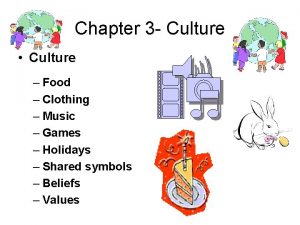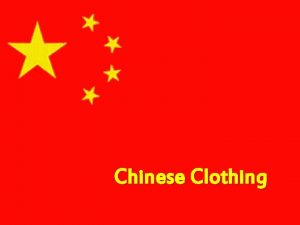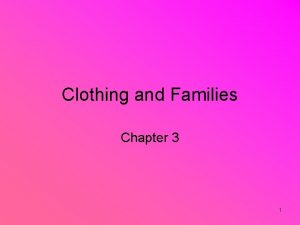Clothing culture Aya Alsarkhi Tasneem Algweery Clothing also



![Traditional clothing in India Main article: Sari A saree or sari[22][23] is a female Traditional clothing in India Main article: Sari A saree or sari[22][23] is a female](https://slidetodoc.com/presentation_image_h/0d9e4b3ce9e448b5f3a7a6d1cea7f460/image-4.jpg)


![Traditional clothing in Morocco The traditional dress for men and women[1] is called djellaba; Traditional clothing in Morocco The traditional dress for men and women[1] is called djellaba;](https://slidetodoc.com/presentation_image_h/0d9e4b3ce9e448b5f3a7a6d1cea7f460/image-7.jpg)



- Slides: 10

Clothing culture Aya Alsarkhi , Tasneem Algweery

Clothing (also known as clothes and attire) is a collective term for garments, items worn on the body. Clothing can be made of textiles, animal skin, or other thin sheets of materials put together. The wearing of clothing is mostly restricted to human beings and is a feature of all human societies. The amount and type of clothing worn depend on body type, social, and geographic considerations. Some clothing can be gender-specific. Physically, clothing serves many purposes: it can serve as protection from the elements and can enhance safety during hazardous activities such as hiking and cooking. It protects the wearer from rough surfaces, rash-causing plants, insect bites, splinters, thorns and prickles by providing a barrier between the skin and the environment. Clothes can insulate against cold or hot conditions. Further, they can provide a hygienic barrier, keeping infectious and toxic materials away from the body. Clothing also provides protection from ultraviolet radiation. Wearing clothes is also a social norm, as being deprived of clothing in front of others may be embarrassing, or not wearing clothes in public to the extent that genitals, breasts or buttocks are visible could be seen as indecent exposure.

Traditional clothing in Jordan he dress of Jordanians varies by region, for example in Amman and Irbid it’s natural for people to dress in what you find in most modern cities, jeans and a t-shirt. More rural regions and Bedouin they wear more traditional clothing. For the men it’s usually a kuffyeh and a thobe (see picture) For the women they wear handmade embroidered dress sometimes with a hijab (see picture) Colors are usually black and red, as well as incorporation of gold at times. For the keffyeh it’s red and white, usually with a ring holding it down as well.
![Traditional clothing in India Main article Sari A saree or sari2223 is a female Traditional clothing in India Main article: Sari A saree or sari[22][23] is a female](https://slidetodoc.com/presentation_image_h/0d9e4b3ce9e448b5f3a7a6d1cea7f460/image-4.jpg)
Traditional clothing in India Main article: Sari A saree or sari[22][23] is a female garment in the Indian subcontinent. [24] A sari is a strip of unstitched cloth, ranging from four to nine meters in length, that is draped over the body in various styles. These include: Sambalpuri Saree from East, Mysore silk and Ilkal of Karnataka and, Kanchipuram of Tamil Nadu from South, Paithani from West and Banarasi from North among others. [25] The most common style is for the sari to be wrapped around the waist, with one end then draped over the shoulder baring the midriff. [24] The sari is usually worn over a petticoat. [26] Blouse may be "backless" or of a halter neck style. These are usually more dressy with a lot of embellishments such as mirrors or embroidery and may be worn on special occasions. Women in the armed forces, when wearing a sari uniform, don a half-sleeve shirt tucked in at the waist. Teenage girls wear half-sarees, a three piece set consisting of a langa, a choli and a stole wrapped over it like a saree. Women usually wear full sarees. Indian wedding saris are typically red or pink, a tradition that goes back to India's pre-modern history. [27]

Saris are usually known with different names in different places. In Kerala, white saris with golden border, are known as kavanis and are worn on special occasions. A simple white sari, worn as a daily wear, is called a mundu. Saris are called pudavai in Tamil Nadu. In Karnataka, saris are called Seere. [28] The traditional production of handloom sarees is important to economic development in rural communities. [29]

Traditional clothing in Japan There are typically two types of clothing that the Japanese wear: the Japanese clothing (和服 wafuku), such as kimonos, and Western clothing (洋 服 yōfuku). The Japanese culture has been greatly impacted by the rest of the world throughout history. One of the most noticeable changes in Japanese culture is the clothing: traditional and modern day clothing. Kimonos and kosodes are two of the most popular traditional Japanese items of clothing. While the traditional ethnic garments of Japan are still in use, they are mainly worn for ceremonies and special events, funerals, coming-of-age ceremonies, and festivals. In more recent years, western clothing is worn often in day-to-day life. While the westernization of fashions has continued at a rapid pace, the kimono lives on in Japanese culture.
![Traditional clothing in Morocco The traditional dress for men and women1 is called djellaba Traditional clothing in Morocco The traditional dress for men and women[1] is called djellaba;](https://slidetodoc.com/presentation_image_h/0d9e4b3ce9e448b5f3a7a6d1cea7f460/image-7.jpg)
Traditional clothing in Morocco The traditional dress for men and women[1] is called djellaba; a long, loose, hooded garment with full sleeves. The djellaba has a hood that comes to a point called a qob. The qob protects the wearer from the sun or in colder climates, like the mountains, the qob keeps in body heat and protects the face from falling snow. For special occasions, men also wear a red cap called a bernousse, more commonly referred to as a Fez. Women wear kaftans decorated with ornaments. Nearly all men, and most women, wear soft leather slippers with no heel, -— ( ﺑﻠﻐﻪ balgha ( often dyed yellow. Women also wear high-heeled sandals, often with silver or gold tinsel. The distinction between a djellaba and a kaftan is the hood on the djellaba, while a kaftan does not. Most women’s djellabas are brightly colored and have ornate patterns, stitching, or beading, while men's djellabas are usually plainer and colored neutrally.

Traditional clothing in France In general, traditional men's clothing in France consists of six basic pieces. The chemise is a linen undershirt, and culottes are knee-length pants. Men wear a pair of hose, or knee-high socks, and mitasses are protective garters worn atop the lower legs. A guillette is a small, short vest worn over the chemise, and the capote or justacorp is a heavy coat with large cuffs worn over the entire outfit.

Traditional French women's clothing have four basic pieces. A chemise is worn under everything, and is comparable to an underskirt or shift. A jupon is similar to a skirt, and more than one is worn to indicate wealth and status. French women wear a mantlet, or a short waistcoat, on top as a shirt. The outfit is finished off by a fichu, which is a square piece of cloth used modesty scarf and is worn around the neck and shoulders. Nearly all traditional French women's outfits are topped off by some type of cap or other head wear.

Students work : Aya Alsarkhi , Tasneem Algweery



















